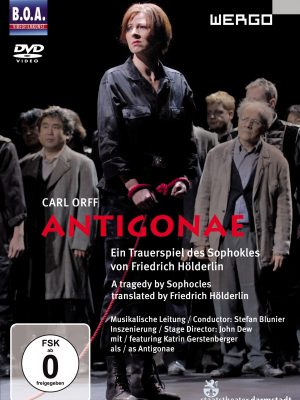Musica Viva DVD 5
€14,95
Musica Viva DVD 5
The blue sea (from: Retreat day)
The composition ends with Franz Schubert’s song Der Wanderer. Helmut Oehring quotes it in part verbatim, and the voice articulates the entire text on Schubert’s pitches, although the rhythm is altered, resulting in a different “swing” of the melody.
Description
The blue sea (from: Retreat day)
The composition ends with Franz Schubert’s song Der Wanderer. Helmut Oehring quotes it in part verbatim, and the voice articulates the entire text on Schubert’s pitches, although the rhythm is altered, resulting in a different “swing” of the melody. It occasionally seems to falter or stumble, as if the composer is remembering the piece. The song takes on the character of a reminiscence of something from the past, which we know very well, but which is overlaid in many ways by other experiences and adventures, and the orchestral accompaniment also contributes to this impression. It sounds quiet and restrained. It consists of long, sustained sounds from which melodic motifs and occasional fluttering figures emerge. || This ending hints openly at the theme of the piece, which lasts around thirty minutes. It is about memory and longing. The Schubert quote hints at this on several levels. The text of the song articulates the longing for a “hopeful green land”, which is associated with the melodic gesture of Schubert’s composition. Both refer to Romanticism in music, literature and art, as a reminder of a bygone era. At the same time, this memory carries a piece of the present, because the multiple flattening of the romantic in pop songs and pop, but also in the expressively backward-looking new music, recur to similar longings and desires, however embellished and clichéd they may be. || Finally, very personal reminiscences of the composer play an important role. Das Blaumeer is a work peppered with memories of Helmut Oehring’s youth, for whom music is not an abstract play of shapes and forms with no connection to the real world. Oehring regards sound as a medium for telling stories. His pieces are sound stories based on real-life experiences. When composing, he tries to create connections to the extra-musical, either by referencing events in society and politics or through the personal, as in the case of Das Blaumeer. || Such a connection is made, for example, by a few short passages in the voice that are heard in the middle of the piece. The soprano articulates a kind of secret language, as Oehring used to do in his childhood: the text is spoken backwards and thus encrypted. Another connection to his personal world of experience is the use of the electric guitar, which Helmut Oehring has played since the age of 14. His entire sound thinking is shaped by it. In Das Blaumeer, the electric guitar plays a central role as a solo instrument. It forms the center of gravity for the two other soloists, soprano and trumpet, and it also influences the sound of the orchestra. || Oehring develops a sensitive interplay. The electric guitar reflects to a certain extent what the other two soloists are emitting, or to put it another way: the soloists perform what is implied in the electric guitar. The instrument intones a certain gesture that corresponds to the character of the respective section. At the same time, it adds noisy elements. Distortion and other electronic devices are used to manipulate the sound, which leads the sound of the electric guitar into the most diverse worlds of noise. One of these is a sound that Oehring calls “radiophonic” or “radioelectric”. It sounds like the interference of a small transistor radio with poor reception, which the composer remembers from his childhood listening to the radio under the comforter. These noises flow discreetly into the overall sound. They form a kind of veil that discolors and alienates the instrumental sounds. || Helmut Oehring has integrated another childhood association into the trumpet part. As the son of deaf parents, his mother tongue is sign language. His parents also tried to familiarize the child with the sounds of the voice and articulated what they could. Oehring remembers his mother’s very deep voice. It is musicalized in the trumpet part by a so-called “pitchbender”. This is a device that uses a light sensor to measure the distance and angle to the instrument and determines a tone from this data. In Das Blaumeer, the device is set in such a way that in most cases the synthesized pitch is significantly, sometimes up to two octaves below the blown note. This produces deep, grumpy sounds that Oehring associates with the sound of his mother’s voice. At the same time, the process reflects characteristics of sign language, as the pitch bender’s activities are initiated by precisely calculated movements. The gestural nature of these play actions, the production of sound through movement, is very similar to the function of sign language. || All these references to content are abstracted from their origin. They appear transposed into specific sound forms through musical techniques. For Helmut Oehring does not write program music. The very striking thematic elements that the composer names and from which he generates the composition are not simply legible. They appear as gestures of music. As a result, they detach themselves somewhat from their meaning and unfold as independent musical figures. Even the most direct reference to the theme of longing and memory, the Schubert song, is alienated. It appears as a sample in a contemporary sound space that carries many other things in addition to associations with aspects of Romanticism. The processing of the content creates certain moods. They sensualize longing and memory, but not with clichéd acoustic images, but in a complex, rather abstract and contemporary way. || A lot depends on the very physical and, thanks to electronic enhancements, wide-ranging sound of the electric guitar. The orchestra is also affected by this. All instruments are amplified and fed to a surround system via a central console, which is precisely prescribed in the score. The audience is surrounded by sound. It sits in the middle of the instruments, so to speak, and is therefore intensely, almost directly involved in the acoustic action. The orchestra no longer forms a counterpart to the listener, but plays around him in multiple perspectives. The sound is also changed by the electrical amplification. It appears partially detached from the instruments and gains an additional body, an aura of technology. It moves a little in the direction of non-instrumental sounds and approaches the pre-produced feeds. || These consist of a series of noises, the sound of the sea, birdsong, wind and voices, which Helmut Oehring recorded and edited for a number of feeds that atmospherically charge the orchestral sound. Thanks to the electronic amplification and the spatial arrangement of the orchestra, these elements of a musique concrète do not seem like foreign bodies. Both instrumental sound and noise merge together. And the associations with nature contribute to the mood that Helmut Oehring wanted to create with the piece: the climate of a sultry summer’s day. The performance situation, which breaks with the usual concert atmosphere, also follows this idea. The hall is to be bathed in a mild, daylight-like blue light throughout the entire piece. || The dedication in the score does not refer directly to the music, but to the theme of the composition. Oehring lists the missing children in Germany, their names, ages, places of residence and dates of disappearance. He combines a socio-political problem with a personal concern to musicalize his own memories. This is a recurring aspect of Helmut Oehring’s composing. He wants to somehow interweave the musical work with reality, because he sees no point in music just for the sake of music. With the dedication to the missing children, Das Blaumeer gains a thematic dimension that places the very personal treatment of the subject of longing and memory in a supra-individual context.
Instead of a dedication, two of the well over a thousand
permanently missing children in Germany [as of June 17, 2003] are listed below.
The author asks that for each BLAUMEER performance, one missing child from Berlin and one from
in the city where the performance is taking place – with all details, photo and telephone number of the
hotline – be depicted in the program booklet.
Till Kratzsch
from Berlin
Missing since July 18, 1995
Age: 13 at the time
Height: 1.60 m
Eyes: blue
Hair: dark blond/curly
Special features: thick, fused
eyebrows; vertical scar on forehead
Patrick Jesch
from Veitshöchheim/Würzburg
Missing since October 31, 1998
Age: 2 years at the time
Height: approx. 91 cm
Weight: approx. 16 kg
Hair: dark blond, medium length, curly
Eyes: blue
Face: oval, high forehead, snub nose
Shape: sturdy [nicht dick]
Clothing: white-grey jogging suit, dark blue
patterned anorak, denim cap, high
black lace-up sneakers
If you have seen Till Kratzsch or Patrick Jesch or have heard anything about him, please contact
the Würzburg police, phone: 0931 / 45 74 10, any other police station or us:
Parents’ Initiative for Missing Children
http://www.vermisste-kinder.de
Hotline: 0700 – VERMISST [0700 – 83 7647 78]
Pommernstr. 9
24629 Kisdorf
Phone: 04193 / 89 09 98
Fax: 04193 / 96 88 23
E-mail: info@vermisste-kinder.de
With the kind help and permission of the Parents’ Initiative for Missing Children
Donation account: Deutsche Bank | Account: 23 48 480 | Bank account no.: 200 700 24




